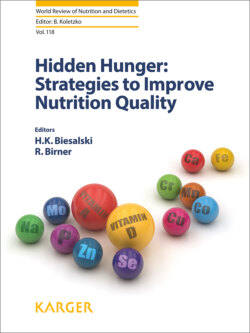Читать книгу Hidden Hunger: Strategies to Improve Nutrition Quality - Группа авторов - Страница 15
На сайте Литреса книга снята с продажи.
Economic and Political Innovations for Better Nutrition
ОглавлениеIn view of the noted complexities, an effective policy for improved nutrition needs a framework that helps in understanding causal relations of determinants, and shaping priorities for action. An aggregate but comprehensive conceptual framework is presented in Figure 2. The concept takes a broad perspective on the food and agricultural sector, income and employment, markets and services, and hunger and malnutrition. Institutions, information, and behavior are cross-cutting issues that influence linkages in all the domains that describe the framework. Generally, all 4 dimensions in Figure 2 and their interrelations can benefit from innovations making the food and nutrition system more effective, efficient, and resilient.
Even in a rather aggregate framework such as presented here, at least 6 critical linkages need consideration when addressing hunger and malnutrition (see arrows in Fig. 2). Overarching and surrounding are environmental as well as macroeconomic framework conditions. Related linkages exist at large or even global scale, such as greenhouse gas emissions through land use change, and at local scale, such as water and sanitation in the context of irrigated agriculture and waste disposal. All the links operate with diverse dynamics under short- or long-term time lags, which require attention in policies and programs. Structural problems, such as access to markets and resources including land, have to be considered and there are risks affecting the resilience of poor people and low-income countries, often eroding societal cohesion. Furthermore, a multitude of drivers far beyond agriculture can shape food security in positive or risky ways, for example, bio-energy systems, financial markets integrated with food commodity markets, novel non-land-based foods, and more. Priorities in targeting nutritional problems can be identified from this framework. Targets for economic and political innovations are to
1 Increase investment in food and nutrition research and development (R&D),
2 Provide more innovative social protection, transfer, and nutrition enhancement programs,
3 Strengthen communities’ own innovation capacities, including for improved health, sanitation, and water environment, and
4 Improve nutrition in complex emergencies.
Furthermore, policy makers should seek innovation in the implementation process [7]. Outcomes of an implementation process are different degrees of implementation, from “paper implementation,” to process implementation, to performance implementation. The outcome of an intervention process on the other hand is an established evidence base. Interventions and implementation research have different target groups. Interventions focus on groups of people such as children, women, the infected, or the undernourished. Implementation on the other hand focuses on client groups such as practitioners, managers, organizations, or communities (in systems). For accelerated success with economic and policy innovations for nutrition, a stronger focus on policy and program implementation is called for, since it is critical for impact.
